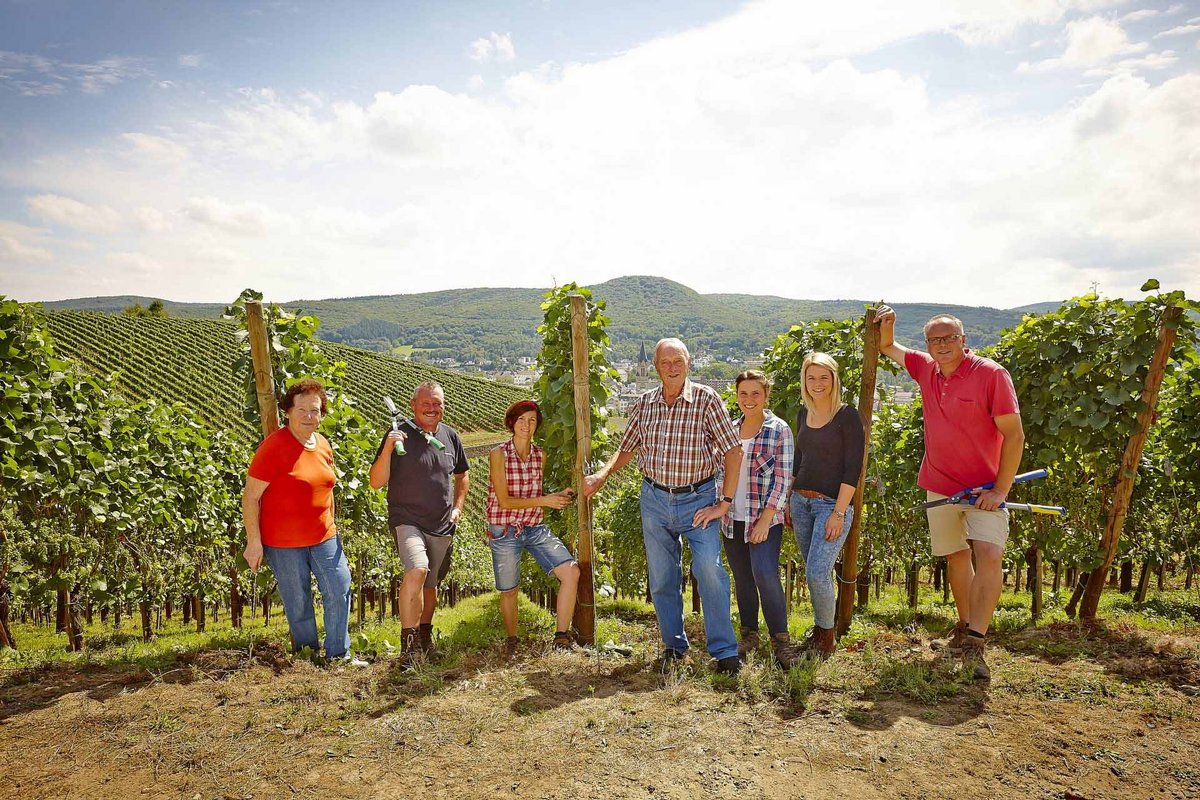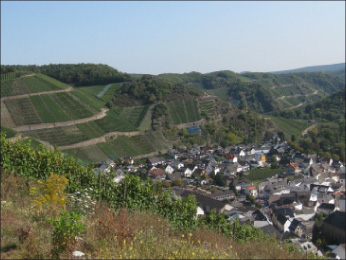Vintners’ cooperatives in the Ahr valley (Germany) – a success story
Vintners’ cooperatives in the Ahr valley (Germany) – a success story
“We do not have any generational or sales problems here”
by Gerda Reuter
When the queen of wine and wine god Bacchus parade through the narrow streets of Dernau, accompanied by musical processions and fancyful themed groups, the entire village population is active: they serve the densly standing visitors on wine and food stands or present themselves to the cheering guests in decorated floats and parades. They generously pour wine to the visitors who line the road, usually red wine which is traditionally cultivated here in the Eifel.
Visitors come from Cologne, Bonn, Düsseldorf, the Ruhr area, Holland, Belgium, Luxembourg. Also, Scandinavian buses are to be seen.

History of Ahr wines and the vintners’ cooperatives of the Ahr
The Ahr valley is a side valley of the Rhine, south of Bonn. The Ahr region is one of the northernmost wine-growing regions in Europe.
We know that the Romans brought viticulture to the Ahr. It seems, however, that even the Celts learned viticulture from the Greeks and practiced it. In the middle of the 19th century, the Ahr region - it belongs to the barren Eifel - was heavily impoverished. Phylloxera and climate spoiled the harvest, large parts of the population emigrated to America. A solution had to be found in this emergency. In 1873, the history of the Vintners’ Cooperative Dernau according to the Raiffeisen model began, after the neighbouring municipality Mayschoss, Germany’s oldest vintners’ cooperative, had made a start some years before.
In an interview, Mr Friedhelm Nelles, Managing Director of the Vintners’ Cooperative Dernau, explains the structure:
“Today, 600 vintners are members of the Dernau vintners’ cooperative, who grow wine here at the Ahr on 155 hectares. The Ahr has a total vineyard area of 525 ha, which is why Dernau has become the largest cooperative on the Ahr through mergers. The vintners participate financially with business shares that are based on centners (quintals/hundredweights). A business share costs 1000 euros per 100 centners of grapes.
The tasks in our cooperative are distributed as follows: The vintners grow their grapes, harvest them in autumn and deliver them to the cooperative. The employees of the cooperative are responsible for the maturing, production and marketing. The vintners receive from us a “grape money”, which depends on the level of the Öchsle values (weight of the unfermented grape juice = sugar concentration). When the winegrower has tipped his grapes in autumn and the cellar master has accepted delivery, usually everything has been done by the winegrower. The grapes are processed here, then matured into wine, and we are then responsible for marketing of the wine. We advise our vintners regarding cultivation, give cultivation recommendations, i.e. which grape varieties are in vogue, etc. Viticulture is a long-term thing. Areas have to be cleared and the vines replanted – this is a time-consuming job, and the gain from newly cultivated areas is achieved only after quite a few years.
How was the success brought about?
Asked how the cooperative’s success was avchieved, Mr Nelles explained: “In the eighties there was a glut of wine, which prompted the vintners’ cooperative to restructure the work in the vineyard along the lines of the large wineries. The state government and the EU then considered how to curb the glut. The vintners of the cooperative have changed their work in the vineyard, in the style of the large vintners. They have cut off the superfluous grapes, they have also done the foliage work differently, in this suction the cooperatives have come in. A model was then developed which allows 130 kg to be achieved over an area of 100 m².
There’s a contingent. For example, if the winegrower has harvested 20 centners too much, he does not get paid for it. What exceeds 130 kg cannot be marketed. But since the cooperative is seen as one business, this can contribute to the balance with other vintners. There are individual vintners who are much lower, harvesting only 100 centners and not 130, and then we can market the whole as a cooperative. What we get for the 30 kg will then benefit the general public.
So we have 155 hectares times 130 centners, which is the total marketable quantity that we can market in one year. We can store everything that is above and market it the following year. Other large wine-growing areas are forced to distill their grapes – industrial alcohol is made from it.”
Today, Mr. Nelles said, there were no generation and sales problems at the Ahr, as for example at the Moselle. There, there were generational problems, problems with the payment price, there the vintners would leave the cooperatives and look for other wineries. The Ahr with its area of only 550 hectares is manageable, but for example the municipality of Leiden on the Moselle for itself, is as large as the entire Ahr area. Both areas have steep slopes.
For two years in a row, Dernau presented the German queen of wine, an indication for the good know-how of this region.
Advantages of the Business Model Cooperative
“We have employed a total of 32 people here, including the salespeople. Two members of the Management Board and one honorary Supervisory Board manage the business. Among our vintners there are about 12 full-time winefarms, the others are also active in sideline businesses.
It is the vintners who determine what will become of the cooperative. As board members, we are always under the pressure of the consociates, if our work is not successful and the consociates are not satisfied. Of course, the payout price is the decisive criterion for the vintners. Our vintners are satisfied, otherwise we could not keep 600 vintners in line. If every winegrower had to develop his own wines, he would need the technical facilities and the know-how, he would have to be in possession of the sales channels. The best example of this problem can be seen on the Moselle, where red wine was first cultivated years ago. But behind red wine stands a completely different cellar philosophy than behind white wine, the vintners there have taken years to produce a decent red wine. The winemaking facilities are different from those for white wine.”
The cooperatives cannot have worked that badly then. Let’s take the joint stock company for comparison.
The business model of the joint-stock company has suffered greatly in recent years, as speculations with the share capital was performed. This is not possible with cooperatives because of the strong control. The vintners identify with their company as if it was their own family business.
The tasks of the management
“We hold our meetings at regular intervals to discuss all these matters with the Supervisory Board. Once a year, we hold a general assembly with our vintners directly, and otherwise we are available for the cooperative members by telephone and personally. We always have enough people who volunteer as supervisory board members. The new generation is already in the starting blocks.
We can assess the economic situation, we even have to. We know the sales channels into which we pass our wine. This allows us to adjust our prices accordingly in advance. Of course, this may change in the course of the year, for example, the banks’ crisis has also affected us. The consumer no longer had that much money in his wallet. In principle, the payments we make to the vintners are based on the success of the year. Our members are paid in six instalments. We start on 1 July. Then the first instalment is due.”
Marketing
“We have changed our marketing strategy, our name too. We have been making red wine for a long time, but now we also make excellent white wine. We have developed a different cellar technology. Approximately 15 years ago, it all started with the white wine boom here. There was not enough white wine: Riesling, Pinot Blanc, Pinot Gris. These are the varieties you can find here. In 2003 we started a cooperation with the Mittelrhein cooperative. They deliver the grapes from 4 ha of vineyards to us on the Ahr. We cultivate and market the wines here in our cellars. We have purchased cooling tanks to ensure that the white wine ferments as slowly as possible so that the fruit remains in the wine. We have a strong demand for white wine. Already in August/September we are no longer in a position to deliver.
About 50% of the harvest goes to the direct sales at the sale’s point and to the online shop here, the remaining 50% go to the food trade, the specialist trade and to the local gastronomy. Export is a negligible factor.
Our goal is, of course, to sell directly to the end consumer, because then the revenues are better.”

Tourism and festivals
Today, the Ahr valley is very much influenced by tourism. The main catchment area comprises the Cologne-Bonn area as well as Düsseldorf, Aachen and Mönchengladbach. You’ll be here in an hour by car. Mr Nelles explains: “Unlike in the sixties and seventies, when people came to the Ahr with special trains and buses – we called this the visitors with the skittles club atmosphere – today young families come, but also seniors who hike and stop in. We have here the red wine footpath, also the cycle path along the Ahr, from there meanwhile a completely different clientele has gathered here.
We also organise wine festivals and other events, such as the wine spring or seminars. Its organiser is the tourist office ‚Winzerdorf Dernau’. The local associations also take part in the parade, they build the wagons, for example, and there is a great deal of idealism. The cooperative and the large vintners take part. The cooperative also supplies its wine, but the festivals are not so relevant to sales. Every week, several wine tastings take place in our newly designed sales halls. Sundays is also open and we are pleased about the numerous visits of the guests.” (cf. <link https: www.dagernova.de>www.dagernova.de)
Future
Commenting on the future prospects, Mr Nelles said: “We have no generational problems here. The youth stands by their cooperative.
As far as the cooperative idea is concerned, we have considered, together with the local Volksbanken (cooperative banks) and the schools, to bring the essence of the cooperative system closer to the pupils again. The history of our cooperative is a success story that must be passed on to future generations.” •
(Translation Current Concerns)